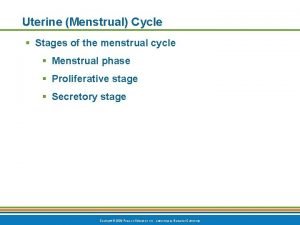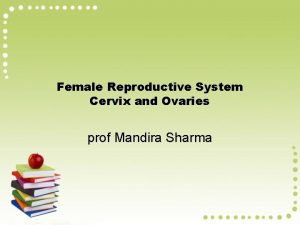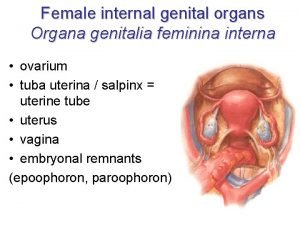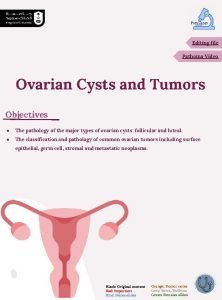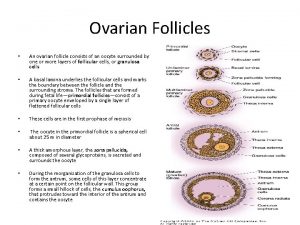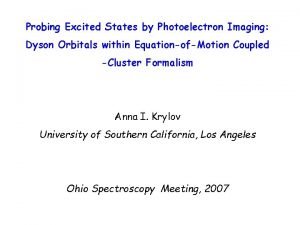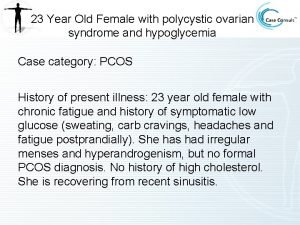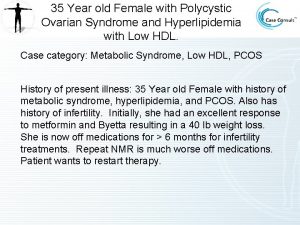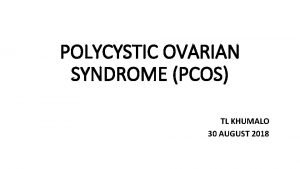Polycystic Ovarian Syndrome Role of Imaging in Diagnosis


















































- Slides: 50


Polycystic Ovarian Syndrome Role of Imaging in Diagnosis DR Seyed Asadollah Kalantari OB & Gynecologist Isfahan Fertility & Infertility Center


Evolution of Criteria for PCOS

Conditions That May Be Considered in Suggested Workup for PCOS Based on ACOG Guidelines

Differential Diagnosis for Hyperandrogenism

The hypothalamic-pituitary-gonadal axis in PCOS

Role of insulin resistance in PCOS

Venn diagram illustrates the Rotterdam criteria for PCOS The diagnosis of PCOS requires two of three criteria to be met, after the exclusion of other diagnoses. These criteria created two new phenotypes for PCOS, in addition to the patient group identified by the original NIH criteria.

Ultra Sound Findings two criteria on the basis of which a polycystic ovary may be identified: • ovarian volume • number of follicles polycystic ovaries are present when : (a) one or both ovaries demonstrate 12 or more follicles measuring 2– 9 mm in diameter. (b) the ovarian volume exceeds 10 cm 3. Only one ovary meeting either of these criteria is sufficient to establish the presence of polycystic ovaries

• Usually, the ovaries are enlarged symmetrically, and the shapes change from ovoid to spherical. • Typically, the ovaries are hypoechoic in relation to the surrounding pelvic fat and myometrium. Polycystic ovaries often display increased echogenicity; however, as many as one third may remain isoechoic or hypoechoic relative to the myometrium.

How the calculation of ovarian volume

Ovarian Volume: • ovarian volume should be calculated on the basis of the simplified formula for a prolate ellipsoid : 0. 5 × length × width × thickness of the ovary. the authors determined the upper limit of the normal range to be 20 cm 3 for premenopausal women and 10 cm 3 for postmenopausal women.

Drawing illustrates how the calculation of ovarian volume is modeled on the volume of an ellipsoid. Mathematically, the volume of an ellipsoid is calculated using the formula π/6 × length × width × thickness. For the purposes of calculating ovarian volume in the evaluation of polycystic ovaries, the simplified formula 0. 5 × length × width × thickness is used.

Sagittal US images of a polycystic left ovary demonstrate axes of measurement corresponding to the three diameters of an ellipsoid.

Transverse US images of a polycystic left ovary demonstrate axes of measurement corresponding to the three diameters of an ellipsoid.

• Sagittal US image through the uterus demonstrates a thickened and echogenic endometrium (arrow).

Number of Follicles : • data suggested that 12 or more follicles 2– 9 mm in size per ovary provided the best threshold for the diagnosis of PCOS • polycystic ovary as one that contains (in one plane) at least 10 follicles arranged peripherally around an echodense stroma.

Transverse US image of the right ovary demonstrates the classic “string of pearls” appearance of a polycystic ovary. This subjective appearance should not be used in place of ovarian volume and follicle count to identify a polycystic ovary, according to the Rotterdam definition.

Selected images from a three-dimensional US examination of the right ovary demonstrate determination of the number of follicles present (follicles numbered 1– 41) across the entire volume of the ovary, according to the Rotterdam definition.

• Data suggest that 23% of women of reproductive age will have findings of polycystic ovaries. However, only 5%– 10% of these women will have classic symptoms of PCOS such as infertility, amenorrhea, signs of hirsutism, or obesity. • One of the earliest described characteristics of a polycystic ovary is an increase in stromal echogenicity. • no standardized method exists for determining stromal volume. Because overall ovarian volume correlates well with stromal volume in polycystic ovaries and is more easily measured in clinical practice, the determination of overall ovarian volume is a reliable surrogate for ovarian stromal assessment.

Degree of confidence : • Ultrasonography has a largely corroborative role in the diagnosis of polycystic ovarian syndrome. • In a patient with a biochemical diagnosis of polycystic ovaries, ultrasonographic findings may confirm the clinical diagnosis, but they cannot exclude it. • Alternatively, the incidental discovery of polycystic ovaries during ultrasonography is not a reliable indicator of polycystic ovarian syndrome.

False positives/negatives : • Almost 30% of patients with endocrinologic findings of polycystic ovaries may have normal-sized ovaries on sonograms. • Less than 50% of patients with biochemical features of polycystic ovaries and increased ovarian volume have the classic finding of multiple, small, peripheral follicles. • The diagnosis should be made on clinical and biochemical grounds. • Correlation with biochemical and clinical findings is necessary before a definitive diagnosis is made.

Abdominal OR Vaginal Sonography ? ?

Imaging and Reporting Considerations • transvaginal US is preferred because it often provides optimal visualization of the internal structure of the ovary, particularly in obese patients. • the appearance of polycystic ovaries may not be detected at transabdominal US in up to 30% of women with PCOS. • If transabdominal US is required, , care should be taken that the bladder is adequately filled but not overfilled, since an overfilled bladder can compress the ovary, potentially leading to a greater deviation from the model of an ellipsoid used to calculate ovarian volume. In addition, it may be helpful to record cine clips through each ovary to assist in counting follicles.

Menstural Cycle Phases & Sonography • Regularly menstruating women should undergo scanning during the early follicular phase (days 3– 5). • Oligo- or amenorrheic women may be scanned at random, or between days 3 and 5 after progesterone-induced bleeding.

Oral contraceptive pills & PCOS • A history of oral contraceptive use should be elicited, since oral contraceptives cause a decrease in ovarian size, thereby decreasing the sensitivity of US evaluation. • women with PCOS are frequently ovulatory. The presence of a dominant follicle (defined as a follicle whose longitudinal, transverse, and anteroposterior diameters average more than 10 mm) or corpus luteum may increase the ovarian volume above the 10 -cm 3 threshold. Such a finding should prompt repeat scanning during the next menstrual cycle.

Sagittal and transverse US images of the left ovary demonstrate a dominant follicle (arrow) with an average diameter of more than 10 mm.

Sagittal color Doppler US image of the right ovary in a different patient demonstrates the presence of a corpus luteum (arrow).

Asymethric Ovaries

• Similarly, the presence of asymmetry in ovarian volume should prompt further investigation for an underlying cause, such as an isoechoic cyst or corpus luteum. • The range of follicular sizes, as well as the size of the largest follicle in each ovary as determined based on the average of measurements taken in three axes, should be evaluated and reported. • the presence of a single ovary fitting the Rotterdam definition is sufficient to diagnose polycystic ovaries. • bilateral ovarian volumes greater than 10 cm 3 correlate with the presence of PCOS in patients between 12 and 20 years of age if they have concurrent symptoms of menstrual irregularity.

GNRH agonists OR IUD ?

IUD in a patient who was being evaluated for polycystic ovaries. (a) Sagittal transvaginal US image through the midline uterus demonstrates the presence of an IUD (arrow) in the endometrial cavity. Progesterone-eluting IUDs are sometimes placed in patients with PCOS in an attempt to reduce the risk of endometrial cancer. (b) Longitudinal transvaginal US image reveals a polycystic ovary.

Pertinent Reporting Parameters in PCOS

Other Conditions That May Be Considered in Suggested Workup for PCOS Based on ACOG Guidelines

VOCAL Image

• There are two basic methods employed to calculate volume from a 3 D data set: - the conventional ‘full planar’ method - computer-aided analysis (VOCAL)-imaging program ( Volume calculations have proven to be highly reliable and valid both in vitro and in vivo with either method, although the newer rotational method appears statistically superior. ) • the VOCAL-imaging program in 3 D ultrasonography facilitates the assessment of total blood flow through the quantification of the power Doppler signal within the defined volume of interest, allowing the objective assessment of total vascular flow within an organ or a specified volume of tissue.

The role of three-dimensional ultrasonography in PCOS • 3 D ultrasound provides a new method for the objective quantitative assessment of follicle count, ovarian volume, stromal volume and blood flow within the ovary as a whole. • 3 D ultrasound is a relatively new imaging modality that has the potential to address number of antral follicles, ovarian & stromal volume and improve the sensitivity and specificity of ultrasound in the diagnosis of PCOS. • 3 D ultrasound not only permits improved spatial awareness and volumetric and quantitative vascular assessment but also provides a more objective tool to examine stromal echogenicity through the assessment of the mean greyness (MG) of the ovary.

A) Three-dimensional volumetric reconstruction by virtual organ computer-aided analysis allows ovarian volume calculation (22. 018 m. L). B ) Automatic volume calculation software gives the follicular count (17 follicles) and mean volumetric calculation (red rectangle)


The role of Power Doppler ultrasound or colour power angiography in PCOS • Power Doppler ultrasound has the advantage of being more sensitive to low flow, and thus overcomes the angle-dependence and aliasing of standard colour Doppler. • It displays the total flow in a confined area, giving an impression similar to that of angiography. • This implementation of the 3 D display permits the physician to see three dimensions on the screen interactively, rather than mentally assembling the sectional images. • Thus, the 3 D power Doppler system may enable physicians to study the region of interest in more detail.

• The size and position of the ovaries makes it an ideal organ for using transvaginal 3 D power Doppler ultrasonography to quantify the Doppler signals within the entire ovary. • it is more accurate than the methods previously reported used to measure blood flow changes in PCOS because the 3 D power Doppler histogram analysis can quantify the whole ovarian stroma Doppler signal via a 3 D reconstructive figure, which can really reflect the whole stroma flow data while 2 D power Doppler cannot.

Three-dimensional (3 D) power Doppler ultrasonography histogram analysis in a polycystic ovary syndrome (PCOS) patient.

Use of MRI imaging for the assessment of PCOS • MR imaging is recommended in cases in which US is inconclusive or nondiagnostic. • The use of MR imaging is generally not warranted in the evaluation of polycystic ovaries due to its increased cost and the typically adequate visualization of the ovaries at transvaginal US. • MR imaging may be helpful in cases in which transvaginal US cannot be performed and transabdominal US does not offer adequate visualization (eg, in cases of extreme obesity).

• The characteristic T 2 -weighted MR imaging appearance of a polycystic ovary is described as consisting of abundant hypointense central stroma with small peripheral T 2 -hyperintense cysts. • Although polycystic and normal ovaries appear to be distinguishable at MR imaging , the literature on MR imaging in PCOS is scant, and no consensus has been reached as to an MR imaging definition for a polycystic ovary. • Until more is known about the performance of MR imaging versus US, it may be practical to report follicle counts and ovarian volume if MR imaging is performed for the assessment of polycystic ovaries.

• Polycystic ovaries are characterized by: - Numerous, small (< 1 cm) - Peripheral cysts that are located throughout the cortex - The ovaries may be slightly larger than normal - Ovarian stroma is hypertrophic - Often, the fibrous capsule surrounding the ovary is prominent. • Changes seen in polycystic ovaries have also been noted in patients without polycystic ovarian syndrome, in patients with oligomenorrhea without a diagnosis of polycystic ovaries, and in patients taking exogenous steroids or clomiphene.

Coronal and axial T 2 -weighted MR images obtained in a young woman demonstrate polycystic ovaries (arrows) with the characteristic appearance, consisting of abundant hypointense central stroma with small, peripherally arranged T 2 -hyperintense follicles

Use of CT scan for the assessment of PCOS • CT is not used in the evaluation of patients with possible PCOS, since the internal ovarian structure is far better depicted at US or MR , • polycystic ovaries may sometimes be seen in such patients when they undergo CT for other reasons.

Axial noncontrast CT image through the pelvis demonstrates bilateral polycystic ovaries (arrows) on either side of the uterus (*). Longitudinal gray-scale US image obtained in the same patient depicts the polycystic morphology of the right ovary.

 Infantile polycystic kidney
Infantile polycystic kidney Symptomatic polycystic kidney disease
Symptomatic polycystic kidney disease Frc control system
Frc control system Types of nursing diagnoses
Types of nursing diagnoses What is the nursing process
What is the nursing process Perbedaan diagnosis gizi dan diagnosis medis
Perbedaan diagnosis gizi dan diagnosis medis Medical diagnosis and nursing diagnosis difference
Medical diagnosis and nursing diagnosis difference Second phase of nursing process
Second phase of nursing process Osteochondrosis
Osteochondrosis 1152020
1152020 Kara potter
Kara potter Nephrotic syndrome differential diagnosis
Nephrotic syndrome differential diagnosis Mountain spotted fever
Mountain spotted fever Ovarian ligament
Ovarian ligament Benjamin cummings
Benjamin cummings Immature teratoma
Immature teratoma Functions of ovaries
Functions of ovaries Ovarian ligament
Ovarian ligament Ovarian cancer brca
Ovarian cancer brca Feminina organa genitalia
Feminina organa genitalia Ovarian benign tumor
Ovarian benign tumor The ovarian cycle
The ovarian cycle Ovarian cycle
Ovarian cycle Ca 125
Ca 125 Female.anatomy
Female.anatomy Stroma of ovary
Stroma of ovary Hrd score ovarian cancer
Hrd score ovarian cancer Ovarian cancer causes
Ovarian cancer causes Chapter 16 the reproductive system
Chapter 16 the reproductive system Ovarian teratoma
Ovarian teratoma Ovarian cyst bleeding
Ovarian cyst bleeding Complex ovarian cyst size chart
Complex ovarian cyst size chart Sru consensus ovarian cysts
Sru consensus ovarian cysts Spermiogenesis
Spermiogenesis Ovarian follicle
Ovarian follicle Follicular development diagram
Follicular development diagram Ovarian cycke
Ovarian cycke Ovary duct
Ovary duct Worker role azure
Worker role azure Role making role taking beispiele
Role making role taking beispiele Statuses and their related roles determine the structure
Statuses and their related roles determine the structure Almalence super resolution
Almalence super resolution Language game wittgenstein
Language game wittgenstein Description of a person
Description of a person Velocity map imaging
Velocity map imaging X ray cassette construction
X ray cassette construction Spectral imaging
Spectral imaging Medical imaging terminology
Medical imaging terminology Hoglund brain imaging center
Hoglund brain imaging center Seaview ocean imaging
Seaview ocean imaging Velocity map imaging
Velocity map imaging














